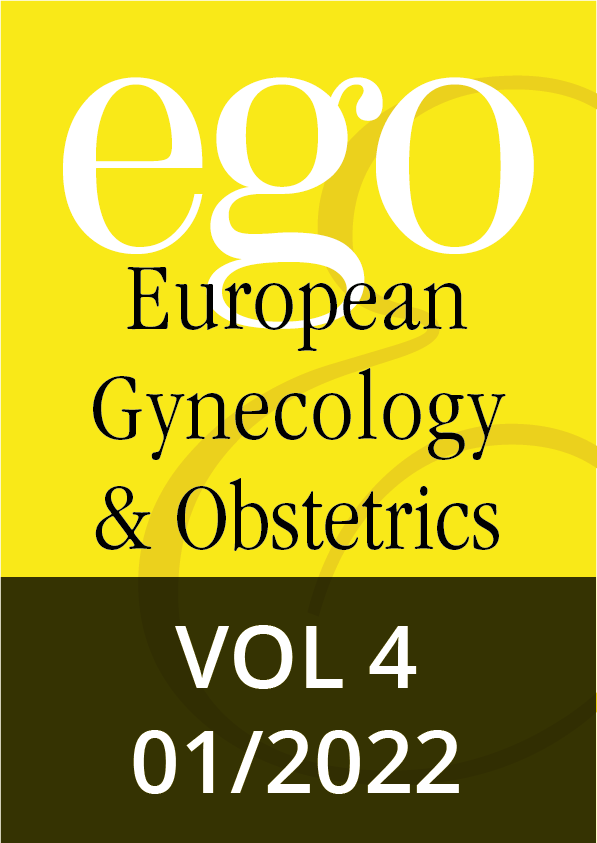Systematic review, 002–011 | DOI: 10.53260/EGO.224011
Reviews, 012-017 | DOI: 10.53260/EGO.224012
Short reviews, 018–022 | DOI: 10.53260/EGO.224013
Case reports, 023–028 | DOI: 10.53260/EGO.224014
Original articles, 029–040 | DOI: 10.53260/EGO.224015
Case reports, 041-048 | DOI: 10.53260/EGO.224016
Case reports, 049–055 | DOI: 10.53260/EGO.224017
Case reports, 056-059 | DOI: 10.53260/EGO.224018
Original articles, 060–064 | DOI: 10.53260/EGO.224019
Can ultrasound reliably assess ovarian endometriomas in pregnancy? A systematic review
Abstract
Background and purpose: There is currently a lack of evidence regarding the diagnostic accuracy of ultrasound in assessing endometriomas in pregnancy. The purpose of this study was to systematically review the current evidence reporting on the diagnostic accuracy of ultrasound in assessing endometriomas in pregnancy.
Methods: The Cochrane Register of Controlled Trials, PubMed and EMBASE databases were searched. All types of clinical studies that utilised ultrasound for the diagnosis of ovarian endometriomas in pregnancy were screened. Only studies that obtained histological confirmation were included. The quality of each study was assessed for risk of bias. The diagnostic performance of ultrasound in each of the study types was calculated, and 2x2 contingency tables were constructed to assess the pooled diagnostic performance of ultrasound in assessing endometriomas in pregnancy.
Results: The initial search yielded 4913 papers, of which 1873 qualified for abstract screening. In total, 17 papers were included which consisted of 1 prospective observational study, 3 retrospective observational studies, 4 case series and 9 case reports. There was a combined adnexal mass count of 207, with histology available for 71 (34%). The mean gestational age at the time of ultrasound diagnosis was 12.150 weeks (95% CI: 6.931-17.369). The mean patient age was 33.750 years (95% CI: 30.738-36.762). In 14 of the 17 studies the modality of ultrasound used was stated: transvaginal in 6/14 (43%) transabdominal in 3/14 (21%), and a combination of the two in 5/14 (36%). The quality assessment scores ranged from 50-100% (mean 73%). The International Ovarian Tumor Analysis (IOTA) Simple Rules were used in 2 studies, while subjective impression was used in 14/17. Overall pooled sensitivity, specificity, positive likelihood ratio (LR+), and negative likelihood ratio (LR−) of ultrasound for detecting endometriomas in pregnancy were 0.77 (95% CI: 0.41-0.95), 0.67 (95% CI: 0.16-0.96), 0.33, and 0.34, respectively.
Conclusion: There is currently a lack of high-quality prospective studies to guide the clinician on how to diagnose and manage ovarian endometriomas in pregnancy. The accuracy of ultrasound in deciphering benign endometriomas from malignant masses appears to be less in pregnant than in non-pregnant women. Further work is required to assess the role of ultrasound models for assessing endometriomas in pregnancy.
Keywords: diagnostic., endometrioma, endometriosis, pregnancy, ultrasound.
Citation: Gaughran J.,Naji O.,Murad A.,Sayasneh A., Can ultrasound reliably assess ovarian endometriomas in pregnancy? A systematic review, EGO European Gynecology and Obstetrics (2022); 2022/01:002–011 doi: 10.53260/EGO.224011
Published: June 1, 2022
ISSUE 2022/01

Systematic review, 002–011 | DOI: 10.53260/EGO.224011
Reviews, 012-017 | DOI: 10.53260/EGO.224012
Short reviews, 018–022 | DOI: 10.53260/EGO.224013
Case reports, 023–028 | DOI: 10.53260/EGO.224014
Original articles, 029–040 | DOI: 10.53260/EGO.224015
Case reports, 041-048 | DOI: 10.53260/EGO.224016
Case reports, 049–055 | DOI: 10.53260/EGO.224017
Case reports, 056-059 | DOI: 10.53260/EGO.224018
Original articles, 060–064 | DOI: 10.53260/EGO.224019
